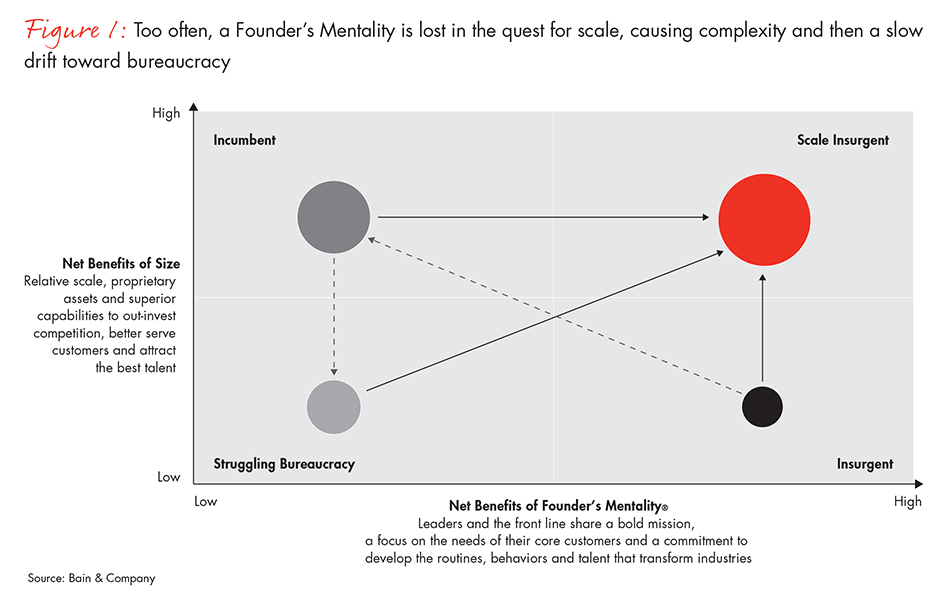Founder's Mentality Blog
Janus is the Roman god of beginnings and transitions, usually depicted with two faces staring in opposite directions. Albert Rothenberg, a psychiatrist well known for his research on the creative process, coined the term “Janusian thinking” to denote the extraordinary benefits that can emerge from considering opposites simultaneously.
Rothenberg writes that some of the world’s most creative thinkers developed their signature ideas and theories by first “conceiv[ing] as simultaneously true and not-true firmly held propositions” about everything ranging from laws of nature to business approaches. A favorite example: Albert Einstein imagined that a man falling from a roof was at rest (relatively) and in motion at the same time—an insight explained by his General Theory of Relativity.
I love the idea that there is genius in the ability to synthesize something new and valuable from a pair of opposites. It helps explain the extraordinary performance of companies that have successfully navigated the journey from small insurgent to market leader—a state of development we call the “scale insurgent.” In the context of the two-by-two diagram we often use to visualize this journey (see Figure 1), these companies have moved to the upper right quadrant by achieving scale without losing the net benefits of the Founder’s Mentality. This is a powerful aspiration that we will be talking about more in upcoming blog posts.


Exploring how to overcome the seeming incompatibility of scale and speed is the central purpose of this blog. Aggressive young companies have a strong Founder’s Mentality—namely, a keen sense of insurgency, an owner mindset and an obsession with the front line. The best large players succeed because of their scale and scope, superior learning systems and the ability to influence markets. The requirements of being good at one seem to be exactly the opposite of the demands of being good another. Consider two examples culled from previous posts:
- We’ve said that founders create great insurgencies. They embrace the notion of limitless horizons, the desire to ignore industry boundaries to create new markets. They are at war against the industry leaders on behalf of underserved customers. Acquiring the benefits of scale and scope, however, requires ruthless focus on a well-defined core business and a passion for continuous improvement. You need stability of systems to improve them.
- We’ve also said that founders embrace chaos by mobilizing and demobilizing resources rapidly and opportunistically. They will do whatever it takes to win and maintain a customer—resources are never trapped behind some other, less critical priority. Large incumbents, on the other hand, tend to be deeply uncomfortable with chaos. Since much of their strength owes to riding down the experience curve, they are heavily invested in fixed routines and behaviors. They need people to stay in place long enough to learn and develop expertise. When market conditions change, they are slow to shift talent and other resources.
Leaders of companies approaching scale too often drift off course as their growing complexity slowly erodes their speed, their sense of insurgency, their focus on the customer. The leaders of scale insurgents—companies such as Lego, Yonghui Superstores, Olam International and IKEA—recognize that being big is often the antithesis of acting small. But they have learned ways to embrace both sides of the problem and then imagine something better. Importantly, they are more than just the sum of their parts. They have managed to forge new amalgams of both scale and speed.
Consider how Yonghui manages through what we call the Engine 1 vs. Engine 2 problem. As companies grow toward scale they rightly focus on building leadership economics in the core business that got them there—Engine 1. But to sustain growth in the future, they need to keep innovating and looking over the horizon by developing an Engine 2, which is devoted to embracing chaos at the fringes of Engine 1.
Yonghui has built a thriving chain of stores in China using Repeatable Models® that deliver safe, fresh produce at reasonable prices to the mass consumer market. These Engine 1 outlets, which Yonghui calls its “red stores,” are devoted to learning, adapting and making the most of the company’s scale. But to keep innovating, the company also has created an Engine 2—a set of “green stores,” where leadership experiments with new formats and ideas, probing for propositions that will delight customers in entirely new ways. Scale insurgents such as Yonghui recognize that it is critical to build both sets of muscles, and they create processes that rotate talent between the two engines, cross-pollinating and learning as they go. By embracing both speed and scale, they create something new and more powerful—a market leader that profits from both scale and the Founder’s Mentality.

About the Founder's Mentality
The three elements of the Founder's Mentality help companies sustain performance while avoiding the inevitable crises of growth.